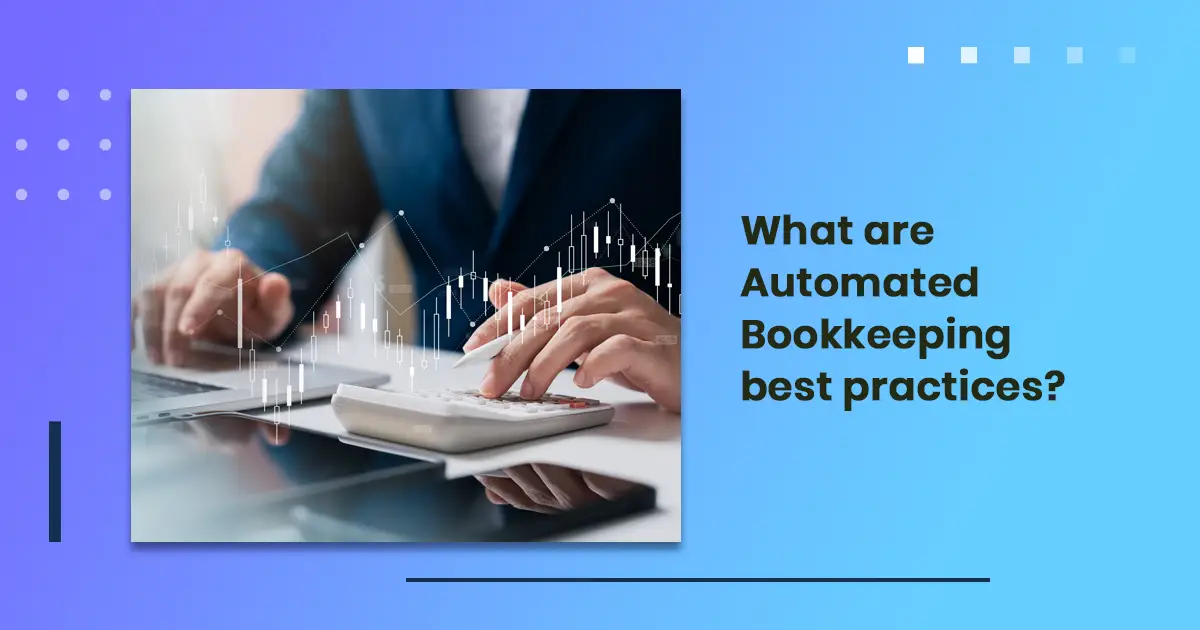
What are Automated Bookkeeping best practices
Dec 29, 2023
The world of financial accounting takes its birth from the elementary bookkeeping practices dating centuries back. Whether we give credit to the Medici family for introducing double entry bookkeeping or modern day bookkeeping, but it is omnipresent and silently making its presence viable.
Even though accountants consider it a mundane task where it is non-objectionable to defer it until month end closings. However, it is a catalyst making all the difference, therefore with realization, comes improvement and innovation. Bookkeeping automation is an offshoot of robotic automation for the Finance and accounting division.
The benefit of bookkeeping automation is it buys time to your accounting team, who can be geared to take up more challenging tasks. Though during the initial stage, it cannot be unmanned but later stages, these tasks function uninterrupted with negligible percentage of supervision.
Let us illustrate how and why your automation system works if these steps are practised.
- Introduce automation to your accounting team in phases:
Automation cannot happen just like ‘the wink of the eye’ to your entire bookkeeping process. Here we need to take two things into consideration;- The team that is going to be impacted with the introduction of robotic automation bots. For this to happen, you need a confidence building mechanism with accountants. The automation team will be supported by accountants to take those processes that are conducive for automation and some to be deferred.
- Program the bot how to perform tasks without disrupting the normal business. Therefore, standardization processes with no human supervision can be taken up in the initial phase.
- Introduce automation to processes the accounting team is familiar:
Automating processes that are non-existent does not add meaning to the effort taken. Therefore, on the onset, take processes which accountants are familiar with. For that to happen, it is will be necessary for the accountants to pinpoint the entire steps needed to perform the task, such as- The frequency rate the processes is done
- Places that are repetitive
- Areas that are prone to error
- Manual time taken to complete the task etc.
Automate something to start with that is recurring and familiar like bank reconciliation etc. - Introduce automation in a way ensuring alignment with the firm’s
objectives:
Automating processes is not just an innovation put in practice, it is a business strategy benefiting the firm’s objectives in both short and long term. Therefore, while the automation team is briefed or given guidelines, ensure it is in alignment with overall firm’s goals. Otherwise, it is a waste of valuable resources.
What are the manual bookkeeping tasks that accountants can easily automate?
A few items to demonstrate are :
Expenditure :
It is the task of the bookkeeper to track the expenses incurred and categorize them to the appropriate account. It takes unnecessary time to read the receipts produced from various sources, extract information from the bank/credit card statements and allocate them. It also becomes an ideal place where mistakes are bound to happen like segregating in a wrong class, numerical errors, giving a credit instead of debit etc.
Robotic automation infused with Machine learning, within no time, learns with past information, analyses its pattern, and draws conclusions based on its logic. The time consuming task is taken care of with accuracy through bookkeeping automation, that your records remain untainted.
Accounts payable and receivable:
The job of accountant becomes critical when it comes to maintaining both the accounts payable and receivable tasks. Only through timely payments to the supplier, the firm will be able to restore their credibility. Internally, the accountant will be able to know the amount of disposable income and infuse cash flow to their operations as required.
With automation, the accountant will be able to swiftly process invoice through fetching details from the PDF copy or OCR. Check the supporting documents attached to the invoice, endorse the invoice, approve them by the authorized accountant and finally clear the payment. This process is done accurately with lesser time, greater efficiency and minimal manpower.
Also read : What gains can be achieved by using robotic automation in accounts payable processes?
Automation also makes it simpler to archive client confidential details and issue corresponding tailor made replies whenever required. It saves time, helps to have a competitive edge, and allows you to concentrate on weaker areas of your business.
Automated Bookkeeping thus becomes a pillar of support to your accounting firm.
This introduction to automated bookkeeping is just the beginning of what’s possible by using robotic accounting automation within a firm. Once you start to research what else automated bookkeeping can handle, you’ll inevitably wonder how you ran your accounting firm without it! Allow us to help you explore the options.
Schedule Your Free Demo
With our accounting automation experts
Find out how other practices have benefited using Integra Balance AI bookkeeping automation. 87% of practices who viewed AI bots in action have instantly discovered the advantages of using them at their firm.
Global Offices
US (Head Quarters)
Integra Global Solutions Corp
7500 Brooktree Road, Suite 100
Wexford (Pittsburgh)
PA 15090
+1 412 267 1529
Philippines
Integra Global Solutions Corp
Ayala Cebu Tower,
Cebu Business park, Cebu 6000
+1 412 267 1529
Europe
Integra Global Solutions UK Ltd
College House
17 King Edwards Road
Ruislip, London, UK, HA4 7AE
+44 (0)20 7993 2949
Canada
Integra Global Solutions Corp
32 Blencathra Hill, Unit 100, Markham
Ontario
+1 412 267 1529
India
Integra Global Solutions Corp
First floor, Kanapathy Towers,
Opp.BSNL exchange, Ganapathy,
Coimbatore – 641 006, India
+91 (0422) 437 9555
Australia
Integra Global Solutions Corp
+61 02 8005 1836
